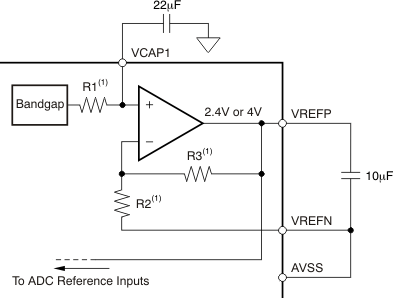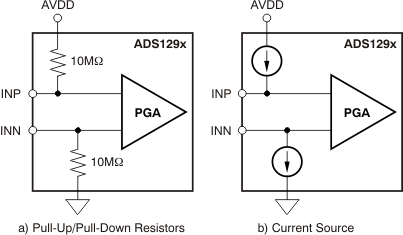SBAU171D May 2010 – January 2016 ADS1198 , ADS1298
-
ADS1298ECG-FE/ADS1198ECG-FE
- Trademarks
- 1 ADS1298ECG-FE/ADS1198ECG-FE Overview
- 2 Quick Start
- 3
Using the ADS1298ECG-FE Software
- 3.1 Application User Menu
- 3.2 Top-Level Application Controls
- 3.3 About Tab
- 3.4 ADC Register Tab
- 3.5 Analysis Tab
- 3.6 Save Tab
- 4 ADS1x98ECG-FE Input Signals
- 5 ADS1298ECG-FE/ADS1198ECG-FE Hardware Details
- ASchematics, BOM, Layout, and ECG Cable Details
- BExternal Optional Hardware
- CSoftware Installation
3.4.2.1 Global Channel Registers
The Global Channel Registers box includes Configuration Register 1 (CONFIG1), Configuration Register 2 (CONFIG2), Configuration Register 3 (CONFIG3), and Lead Off Control Register (LOFF). The upper half of Figure 8 shows the section of the UI panel that allows manipulation and control of these registers.
Configuration Register 1 enables the user to control the resolution mode, enable the daisy-chain configuration options, and program the data rate.
NOTE
Since the HR bit is not available in the ADS1198, the Configuration Register 1 control will not show this control when testing the ADS1198.
Configuration Register 2 enables the user to select an internal square wave test source amplitude of ±1mV or ±2mV and a frequency of DC, 2Hz (fCLK/221), or 4Hz (fCLK/220).
Configuration Register 3 controls the bandgap reference (illustrated in Figure 9) and right leg drive (RLD) options. This register enables the user to select between an external or internal reference voltage, enable/disable the internal reference buffer, toggle between a 2.4V or a 4.0V output voltage, and to enable/disable the RLD as well as choose whether the RLD voltage is provided internally or externally.
 Figure 9. Internal Reference and Buffer Connections
Figure 9. Internal Reference and Buffer Connections The Lead-Off Control Register allows the user to configure the threshold for the lead-off comparator, resistive pull-up or current-source excitation, the lead-off current magnitude, and DC or AC detection. Figure 10 illustrates a simplified diagram of the resistive pull-up and excitation options for the lead-off detect feature.
 Figure 10. Lead-Off Excitation Options
Figure 10. Lead-Off Excitation Options